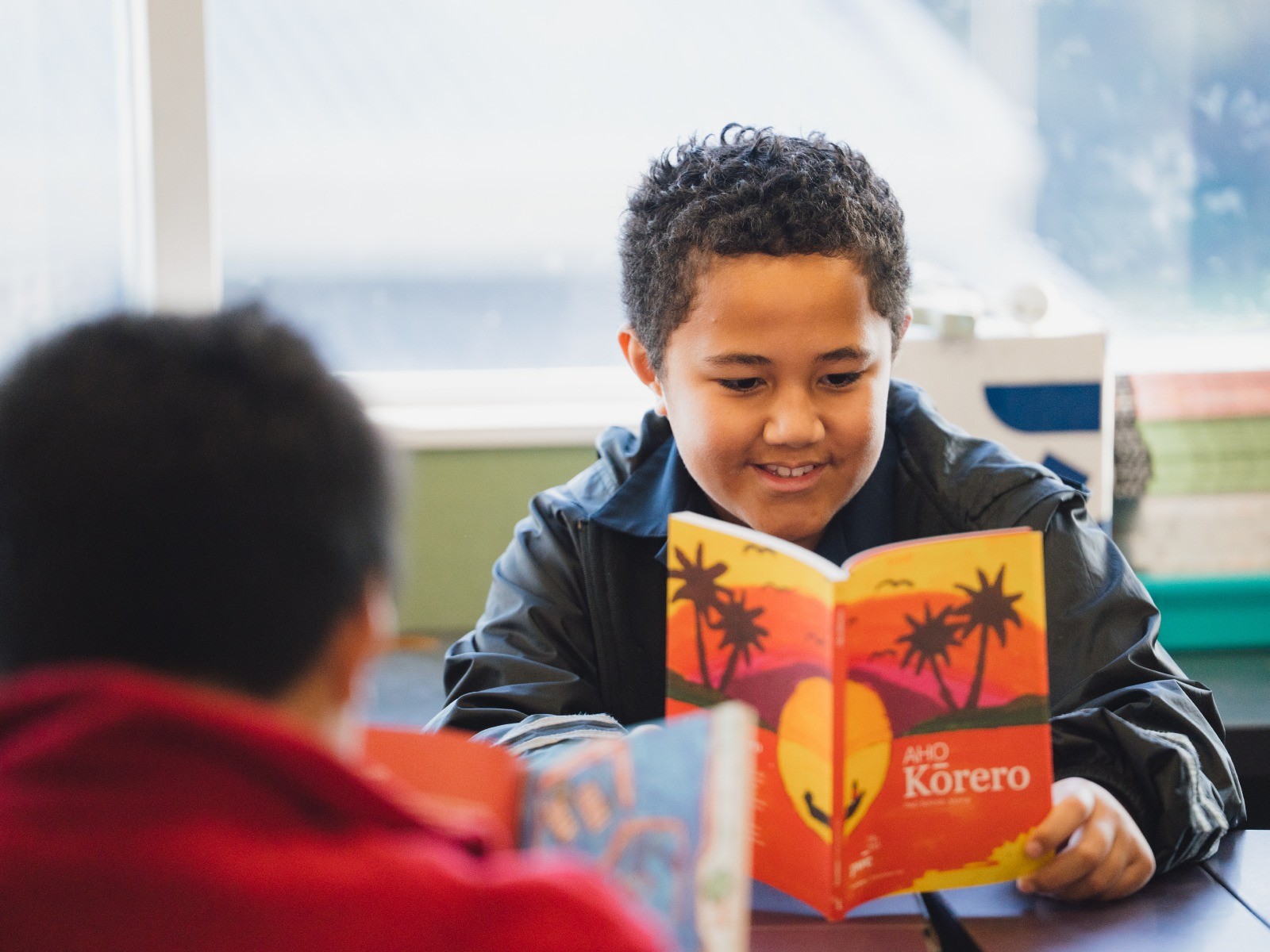The tamariki we connect with all have unique and valuable perspectives, ones that we feel deserve their own platform. This has led to the creation of Aho Kōrero, a PwC schools journal, which publishes writing and artwork exclusively from our partnered schools. Each issue comes with a series of curriculum-aligned literacy activities, games and answer keys corresponding to the journal. Explore, enjoy and create!
Dive into exciting stories with these engaging reading activities! You can enjoy the story by reading the text or following along with the video. Afterwards, test your understanding with quick questions and earn certificates for each story you complete.

Boxing
Aho Kōrero 5 | Page 80

Guess Where I Went?
Aho Kōrero 4 | Page 7

The Bridge
Aho Kōrero 3 | Page 6

The Pocket Watch
Aho Kōrero 2 | Page 46

Ko Mauao te Maunga
PwC Journal 1 | page 34

The Magical Ring
Aho Kōrero 5 | Page 34

Why School Holidays Should be Longer
Aho Kōrero 4 | Page 28

Mission Mystery Door
Aho Kōrero 3 | Page 20

The Beach
Aho Kōrero 2 | Page 34

Martin's Bay
PwC Journal 1 | page 8

Stormy Sea
Aho Kōrero 5 | Page 28

Intergalactic Starship
Aho Kōrero 4 | Page 48

One for the History Books
Aho Kōrero 3 | Page 64

Remembering Matariki
Aho Kōrero 2 | Page 4

Sorrowful River
PwC Journal 1 | page 48
Engage with the stories on your own, with whānau and friends, or with your entire class by hosting these Kahoot quizzes. These quizzes are based on selected stories from each issue of Aho Kōrero, offering an interactive way to explore the content together.

Why I Would Make a Great Prime Minister for a Day
Aho Kōrero 5 | Page 10

Field Trip to Antartica
Aho Kōrero 4 | Page 4

The Present Moment
Aho Kōrero 4 | Page 32

Timebot
Aho Kōrero 3 | Page 12

Ripples of Responsibility
Aho Kōrero 2 | Page 62

My Special Place
PwC Journal 1 | page 4

The Importance of Trees
Aho Kōrero 5 | Page 68

Flying Wonders
Aho Kōrero 4 | Page 72

Birds at my Home
Aho Kōrero 3 | Page 28

The Cat Thief
Aho Kōrero 2 | Page 6

Protector of nature
PwC Journal 1 | page 28

The Three Little Wolves and the Big Fat Pig
Aho Kōrero 5 | Page 48

Savur: Axe of Elements
Aho Kōrero 4 | Page 50

My First Time On Stage
Aho Kōrero 3 | Page 58

The Majestic Ghost of the Mountain
Aho Kōrero 2 | Page 28

Thirteen Years
PwC Journal 1 | page 42
Woohoo! Well done for completing the activities in the PwC Schools journal. If you created some artwork or writing based on any of the activities in the book we would love for you to share them with us! Check out the SUBMIT tab to find out how.
To see how you did with the word find and cross word simply click the cover of the journal that you have been working in, below. Good luck!
We’re so glad you’re here! This must mean you’re ready to submit your work for the next issue of Aho Kōrero. We’re so proud of your courage and bravery and can’t wait to read/look at your wonderful work.
If you are having issues submitting your work using the form above, simply email the PwC Foundation with the following details and attach your work to the email.
Include:
- Authors first name, last name and age
- Illustrators first name, last name and age
- Your School
- Your teacher
- A PDF/Word document with your writing
- A high quality scan of your artwork as an image or PDF
Terms - for submitting your artwork or written work
Please note that by submitting your artwork or written work you agree to the following terms:
- Your artwork or written work could be chosen to be displayed in an upcoming PwC Schools Journal published by the PwC Foundation.
- If selected, you consent to your artwork or written work being displayed in the PwC Schools Journal togetherwith your name, age and school.
- PwC will collect your personal information on name, age, school and handle this information in accordance with the Privacy Act 2020 and our Privacy Policy.
- You consent to PwC and the PwC Foundation using your personal information for the purpose of contacting you, or your school and for display in the PwC Schools Journal and for use in the PwC Schools Journal reading programme and potentially for promotion of the PwC Schools Journal and reading programme.
- All artwork and written work submitted to PwC Foundation becomes the property of PwC Foundation and may be used for any purpose related to the operation of the PwC Schools reading programme.
Reading with your tamariki at home is an incredibly effective way to support their language and cognitive development as well as their emotional development through bonding, all of which serve to improve overall academic success. But where do you start? Good question! We’ve got you covered.
Discuss books together
Show interest in what they’re reading, ask them questions. Here are a couple curriculum aligned questions you could use, but any questions will demonstrate your genuine interest and get their brains ticking.
What’s this story about? [Summarising and retelling information]
What does this character look like? Can you see a picture in your head? Can you draw them? [Recognise and understand the use of specific language features]
Are there any characters in the book that remind you of anyone you know? What’s similar about them? [Making connections between text and real life]
Are there any situations in the book that you’ve experienced before? In real life or a movie or another book? [Making connections between text and prior knowledge]
Do you know what this word means? Can you guess by reading it in the sentence? [Decoding strategies, developing vocabulary]
Why do you think… (eg this character did that)? [Making inferences]
- What do you think happens next? [Make justified predictions]
Research
The aim is to develop a love for reading, so find out what they love and get them reading about it! You could encourage them to look up, read about or research topics they’re interested in, for example:
How many Rugby League teams are there in the world? Which countries play Rugby League?
What kind of money do they use in Japan?
What types of things could you do at Universal Studios in Hollywood?
Can you find a book in the library about dinosaurs?
What are the lyrics of this song? Could you look them up? Where does the singer come from? Can you find any interesting facts about them?
Read together
Perhaps the most powerful way to improve your child’s reading skills is to read with them as often as you can. Show interest in their stories and model an enjoyment of reading. Once tamariki develop a love for reading, their literacy skills will improve exponentially, positively impacting all areas of learning.
Read at whatever level feels comfortable to you both, and try to:
Encourage them to try figure out what the words mean by looking at the whole sentence for context
Explain any tricky words or ideas that are new to them (if you don’t know some words, that’s great! Be honest and look them up together, modelling lifelong learning)
If you’re feeling a bit unsure of reading or helping with words, or perhaps these books aren’t in your first language, you can listen to the audios we upload (or download any audiobook from the library for free) and play them aloud while you and your whānau follow along
Maintain interest
Let’s keep up that interest in reading materials! You could try some of these methods:
Get them to find other books by that author (finding a great series of books is a goldmine for sparking a love of reading!)
Go to the library together and encourage them to pick a book. Explain that you can help decide what book to read by reading the blurb on the back. If they want a book that’s more advanced, you could offer to read it with them if you feel comfortable.
Play games together that rely on reading instructions or prompts.
Pop subtitles on the television, the eye naturally finds them and the actors will model the pronunciation (be careful they don’t end up with American accents!)
Model a love of reading, researching and discussing texts.
Inspired by guidance from The Ministry of Education
Have a gander at our writing resources, we hope these structured literacy aligned materials will guide you through the process of creating some wonderful stories with artwork that you might want to submit for the next issue of Aho Kōrero.

Writing prompts
Structured Literacy aligned
Contact us
Chelsey Roos
















